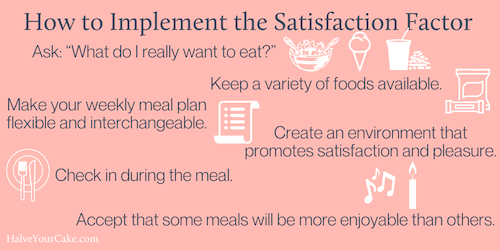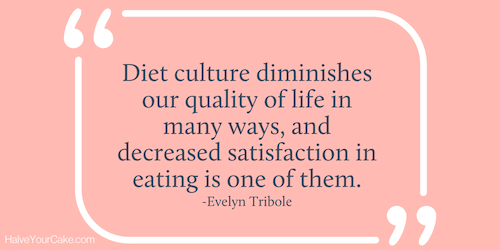Discover the Satisfaction Factor- Intuitive Eating Principle #6
As we continue our series on the 10 Principles of Intuitive Eating, this month we’re discussing the satisfaction factor. We touched on this concept in last month’s overview of principle #5, Feel Your Fullness. As you’ll read more about, these two principles are closely related because true contentment and comfortable fullness can be hard to regularly achieve without paying attention to the satisfaction of food. If you eat foods that you think you “should” eat but deny yourself the foods that you want to eat, it will be hard to honestly evaluate your place on the hunger/fullness scale. The satisfaction of food plays a significant role in how your body processes your physical response to foods. In this post, we’ll define satisfaction and how it manifests in relation to food and eating, we’ll provide tips for how to pursue eating satisfaction in regular, daily life and we’ll go over common effects of ignoring the satisfaction factor.
Let’s start with a definition.
What is satisfaction? Outside of the specific context of eating, Oxford’s Dictionary defines it as: “fulfillment of one's wishes, expectations, or needs, or the pleasure derived from this.” Some synonyms include: contentment, delectation, delight, enjoyment, gladness, gratification, happiness, pleasure. When you read that list, doesn’t your face just light up with a smile? Can you even imagine what our culture would be like if these were the main goals of eating? Satisfaction can also be defined as simply meeting a requirement, but in discussing principle #6 of intuitive eating, we will specifically use the word satisfaction to mean pleasure and enjoyment.
What contributes to satisfaction in eating?
There are countless factors that contribute to the satisfaction of an eating experience, and they go well beyond just the taste of the food. The location or environment, including the people you are surrounded by, impacts satisfaction. The taste and quality of the food impact satisfaction. Cravings impact satisfaction. And eating enough to be comfortably full and nourished impacts satisfaction. Since satisfaction is so individualized, not just to each person but to each unique eating experience, it is not something we can create a formula for. Further, it’s certainly not something that diets or strict eating plans allow for. One of the critical aspects of incorporating satisfaction in eating is being able to decide in the moment what food(s) would be highly satisfying and what kind of eating experience will be most enjoyable.
Living in a diet culture that tells us there’s a right and wrong way to eat or that there are good and bad foods, you might be accustomed to feeling bad when you eat highly satisfying or pleasurable foods. Let this be your official permission slip from a Registered Dietitian: you are allowed to regularly enjoy food and receive pleasure from everyday eating!
So, how do I implement the satisfaction factor?
You can start by reflecting on your past experiences. Think back to times when your satisfaction or enjoyment of a meal was at its peak. Who were you with? What was the environment? What had you been craving and what did you eat? How did you feel afterwards? Begin to think about what aspects of meals appear in many of your most satisfying eating experiences. It could be when you eat a food that you’d been really craving. It could be the times that you get to have a date night or quality time with your significant other. It could be all the times the weather was cold and drizzly and you had a hot, hearty bowl of soup or stew. As we already said, there’s not a formula for satisfaction; we cannot just repeat these meals over and over and expect them to always hit the spot. But what we can do is reflect on why that eating experience was so highly enjoyable, how we created that eating experience (what role we played in fostering the environment, how we chose our food, etc) and how we can implement the same decision-making process in the future to produce highly satisfying meals and snacks as often as possible.
In the moment, a good question to ask is: “What do I really want to eat?”
This is always a good place to start when you try to create a satisfying experience. Assess flavors, textures, smells, appearance, temperature. Do you feel like something sweet, savory, salty, crunchy, soft, creamy, tart, rich, bitter, spicy or bland? Of course, in the rhythm of everyday life, we know you aren’t ordering off a menu for three meals a day plus snacks. It may seem silly to suggest that you can simply choose any food or meal that you are craving at any given moment. But there are still ways you can incorporate satisfaction into regular eating, even when you’re not at a restaurant making an entree selection. Here are a few ideas:
Keep a variety of foods available, when possible. This goes for snacks or quick meals. If you have a desk at work, stock one of your drawers with a variety of shelf-stable snacks that might hit a few different craving possibilities. Something sweet, something salty, something crunchy, something fruity, etc. If you eat breakfast and lunch at home most days, plan to have a minimum of 2-3 options of meals you can choose from. Having options means you set yourself up for a more satisfactory meal or snack.
Make your weekly meal plan flexible and interchangeable. This isn’t always possible; sometimes you have to use a particular ingredient before it goes bad. But when you can, leave your weekly meal plan loose. Plan and shop for a few different meals, but then decide each morning what you feel like for dinner and prep ingredients accordingly. At the very least, this is good practice in allowing yourself to choose what sounds best among the available options.
Create an environment that promotes satisfaction and pleasure. Remember the reflection we did about past eating experiences? What have you noticed makes a meal the most pleasurable? It may not be feasible every time, but if there are things you can do occasionally that increase a meal’s pleasure factor, do them when you can. For example, maybe you have young kids at home and dinner is often chaotic, loud and busy. Perhaps set aside one night a week to have dinner after the kids go to bed or let them watch a movie while you enjoy a nice slow dinner. Some other options for a satisfying environment: light a candle, turn on some music, put away devices, use conversation starters or daily question prompts, put on comfier clothes, invite a friend over or meet a friend out somewhere.
Check in during the meal to assess ongoing level of satisfaction. Sometimes, your first couple of bites will bring a high level of satisfaction, enjoyment, pleasure or delight. As you check back in with yourself during the meal, snack or food, you may realize that the satisfaction is decreasing. This doesn’t necessarily mean you have to stop eating, but it’s good to know and can help you as you think about how you want to feel after the eating experience is over. This ties into principle #5 of feeling your fullness. Pausing frequently to assess how you’re feeling can help you decide when to finish eating to promote health, energy, comfort and fullness.
Lastly, accept that it’s not wrong to eat foods that aren’t the maximum level of pleasurable. It won’t always be practical to eat the exact food you’re craving. If you find yourself feeling bad for eating a “mediocre” meal, remind yourself that this is just what normal eating looks like. Some meals are phenomenal, some meals are simply providing calories to get you through the day.
Pursuing pleasure and satisfaction in eating is simply a part of a healthy, neutral, normal relationship with food. It’s a critical component of Intuitive Eating because it is something that diet culture so commonly removes from eating experiences. Pleasure in eating is not only important for your quality of life, but also for you to feel adequately nourished and comfortably full after meals.
What happens when you abandon the satisfaction factor?
Let’s wrap up by covering the most common consequences of ignoring satisfaction in food. When you ignore a craving and try to choose a “better” or “healthier” alternative, you’re likely to end up munching more as nothing quite hits the spot. Similarly, when a meal isn’t adequately pleasurable, it’s easier to eat well past fullness because you’re not getting that satisfied feeling in your belly and in your brain. When you ignore a craving or choose less pleasurable foods, your thoughts naturally continue to revolve around food, or perhaps you immediately begin planning your next meal. When you ignore cravings and the satisfaction factor in favor of healthier alternatives, you perpetuate a lack of trust with your body. You continue to solidify the idea of certain foods as good and others as bad or off limits. And you are likely to develop feelings (and consequences) of deprivation even when you might be getting adequate calories. Abandoning the satisfaction factor undermines your pursuit of a peaceful relationship with food and with your body.
You deserve satisfaction.
You deserve to eat what you’re craving with no judgement, shame or guilt.
You deserve to eat highly enjoyable foods.
You deserve for food to contribute to a richer and fuller life.
You deserve eating experiences that are life-giving and joy-filled.
Evelyn Tribole wrote, “Diet culture diminishes our quality of life in many ways, and decreased satisfaction in eating is one of them.” If the idea of more enjoyable and pleasurable eating sounds attractive to you, but you feel confused about how to incorporate satisfaction in food, send us a message and we’d love to chat about working together to help you pursue peace, neutrality and enjoyment of food.
Not ready for individual work? Click here to download your free guide on 6 Steps to Heal Your Relationship with Food.







